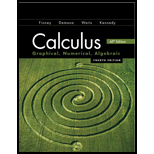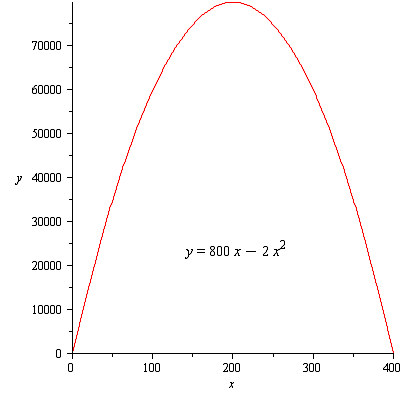
Concept explainers
Find the maximum area of the enclosed dimensions.
Answer to Problem 9E
the maximum area of the enclosed dimensions are
Explanation of Solution
Given information: Given the length of the wire is
Calculation:
Let the dimensions of the rectangular plot is
Is parallel to the river.
Let the area of the triangle be ,
For any function
Critical points and end points
Critical points occur at
solve it graphically, it has critical point occur at
Here
For
Graphical support:

Thus, the maximum area of theenclosed dimensionsare
Chapter 5 Solutions
Calculus 2012 Student Edition (by Finney/Demana/Waits/Kennedy)
Additional Math Textbook Solutions
Pre-Algebra Student Edition
Elementary Statistics (13th Edition)
Introductory Statistics
Thinking Mathematically (6th Edition)
Calculus: Early Transcendentals (2nd Edition)
College Algebra with Modeling & Visualization (5th Edition)
- Prove that if a and b are both positive, then y(x)⭢0 as x⭢∞ for all sloutions y of the questionarrow_forwardShow how to use "Change of Variables Formula for Integrals" to solve "Separable Differential Equations"arrow_forwardUse the two methods "real number solution space basis" and "complex solution space basis" respectively to solve y''+ 4y' + 4y = 0, y(-1) = 2, y'(-1) = 1arrow_forward
- Explain the key points of Theroem 9.3.6arrow_forwardUse the two methods "real number solution space basis" and "complex solution space basis" respectively to solve y''+ 4y' + 4y = 0, y(-1) = 2, y'(-1) = 1arrow_forwardShow how to use "Change of Variables Formula for Integrals" to solve "Separable Differential Equations"arrow_forward
- A helicopter pilot needs to travel to a regional airport 25 miles away. She flies at an actual heading of N16.26°E with an airspeed of 110 mph, and there is a wind blowing directly east at 20 mph. (a) Determine the compass heading that the pilot needs to reach her destination. (b) How long will it take her to reach her destination?arrow_forwardQuestion 3. the given integral is convergent or divergent: Use the comparison test to determine whether or not * sin*(x + 1) 7x3 (a) |. d.x g8 + x4 + 1 -dx (b) 2.x4 + x + 1arrow_forward-d.x tan xarrow_forward
 Calculus: Early TranscendentalsCalculusISBN:9781285741550Author:James StewartPublisher:Cengage Learning
Calculus: Early TranscendentalsCalculusISBN:9781285741550Author:James StewartPublisher:Cengage Learning Thomas' Calculus (14th Edition)CalculusISBN:9780134438986Author:Joel R. Hass, Christopher E. Heil, Maurice D. WeirPublisher:PEARSON
Thomas' Calculus (14th Edition)CalculusISBN:9780134438986Author:Joel R. Hass, Christopher E. Heil, Maurice D. WeirPublisher:PEARSON Calculus: Early Transcendentals (3rd Edition)CalculusISBN:9780134763644Author:William L. Briggs, Lyle Cochran, Bernard Gillett, Eric SchulzPublisher:PEARSON
Calculus: Early Transcendentals (3rd Edition)CalculusISBN:9780134763644Author:William L. Briggs, Lyle Cochran, Bernard Gillett, Eric SchulzPublisher:PEARSON Calculus: Early TranscendentalsCalculusISBN:9781319050740Author:Jon Rogawski, Colin Adams, Robert FranzosaPublisher:W. H. Freeman
Calculus: Early TranscendentalsCalculusISBN:9781319050740Author:Jon Rogawski, Colin Adams, Robert FranzosaPublisher:W. H. Freeman
 Calculus: Early Transcendental FunctionsCalculusISBN:9781337552516Author:Ron Larson, Bruce H. EdwardsPublisher:Cengage Learning
Calculus: Early Transcendental FunctionsCalculusISBN:9781337552516Author:Ron Larson, Bruce H. EdwardsPublisher:Cengage Learning





